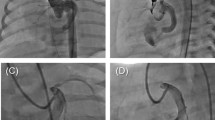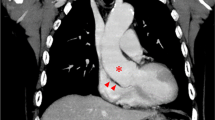Summary
In aortic atresia, coronary perfusion normally occurs through retrograde blood flow in the ascending aorta. We report on two patients with antegrade flow in the ascending aorta despite aortic atresia. In one patient with hypoplastic left heart syndrome (aortic atresia, severe mitral stenosis), an intact interatrial septum/premature closure of the foramen ovale was found. While no other way of left atrial or ventricular decompression was found, echocardiography, angiography and the post-mortem examination showed left ventricular to coronary sinusoids as the sole pathway for systemic oxygenation. In a second patient with complex congenital heart disease, including aortic atresia, antegrade flow in the ascending aorta was through a left coronary fistula with shunt flow originating from the pulmonary trunc.¶ This report describes systemic perfusion depending on retrograde coronary flow due to coronary-cameral (sinusoids) and coronary arterio-venous fistulas leading to the phenomenon of antegrade blood flow in the ascending aorta despite aortic atresia.
Zusammenfassung
Bei Vitien, die mit einer Aortenatresie einhergehen, erfolgt die Koronarperfusion in der Regel durch retrograden Blutfluss in der Aorta ascendens. Wir berichten über zwei Patienten mit antegradem Blutfluss in der Aorta ascendens trotz Aortenatresie: Bei einem Patienten mit hypoplastischen Linksherzsyndrom (Aortenatresie, hochgradiger Mitralstenose) wurde ein intaktes interatriales Septum (vorzeitiger Verschluss des Foramen ovale) gefunden. Während sich echokardiographisch und angiographisch keine anderen Wege einer linksatrialen oder -ventrikulären Dekompression fanden, zeigten sich bei der Autopsie linksventrikuläre, koronare Sinusoide als alleinige pulmonalvenös-aortale Verbindung zur Oxygenation des Körperkreislaufes. Bei einem zweiten Patienten mit komplexer kongenitaler Herzerkrankung einschließlich Aortenatresie fand sich ein antegrader Fluss in der Aorta ascendens durch eine Koronarfistel als Shuntfluss aus der Pulmonalarterie.¶ Hämodynamisch findet sich bei beiden Fällen eine Perfusion des Körperkreislaufs, die von einer retrograden Koronarperfusion bei koronararerio-venöser Fistel und myokardialen Sinusoiden abhängt und zu dem Phänomen eines antegraden Flusses in der Aorta ascendens trotz Aortenatresie führt.
Similar content being viewed by others
Author information
Authors and Affiliations
Additional information
Eingegangen: 16. November 1999/Akzeptiert: 27. Januar 2000
Rights and permissions
About this article
Cite this article
Jux, C., Kaulitz, R., v. Wasielewski, R. et al. Antegrader Fluss in der Aorta ascendens trotz Aortenatresie: Zwei Fallbeschreibungen mit retrograder Koronarperfusion durch koronare Fisteln und Sinusoide. Z Kardiol 89, 502–507 (2000). https://doi.org/10.1007/s003920070221
Issue Date:
DOI: https://doi.org/10.1007/s003920070221




